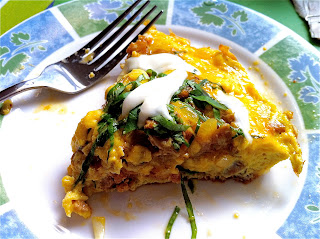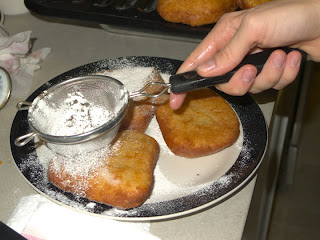Usually, every person knows at least 1 person in his social circle who proclaims he “loves to cook.” You may have been invited (or have tried and failed to wrangle an invitation) to one of his dinner parties, or had a chance to watch him cooking up a storm in action (maybe in that same dinner party), or see and drool over his Instagram photos through dusty monitors. However, have you ever wondered under what circumstances a person becomes an “Iron Chef” in the kitchen?
The obvious answer to this question is that these people like food and have the desire, determination and drive to strive for greatness, but there may be a not-so-obvious answer to this question. I’m not talking about the standard psychology answers where these people’s motives are investigated either, because this is not a psychology blog (although this blog is written by a psycho, this psycho is not board certified). I have noticed some commonalities among these “home Iron Chefs”, and figured I would share them here. Granted, my sample size is very small (1 < n < 10), so it may not be representative, but it’s still some good curd to chew.
1. These people have standards when it comes to food
No doubt the easiest to recognize as a strong contributing factor to the “home Iron Chefs” phenomenon. These people do not eat sub-par food unless they’re forced to. Their palettes just won’t let them eat McD and get away with the dried bun, wilted lettuce, over-cooked burgers and over-processed cheese. Given a choice, they may choose not eating over eating something that can only count as sustenance-- at least for a short period of time (after all, if there’s a famine, they would probably eat anything). People who have low to no standards would not become a “home Iron Chef” because anything goes, and that just doesn’t cut it for these folks.
2. Their standards are not fully supplied by the market
Lots of people have standards when it comes to food. They may not eat a certain thing, or like things made a certain way. Fulfilling #1 only makes you a foodie at best and nothing more. Immersed in the right environment, these foodies would never have to lift a finger and still be able to enjoy the standards that they set forth. I know several people from big cities such as Hong Kong and New York that would rant and rave about certain restaurants’ food, from how they’re prepared down to the minute detail of how the garnish lay on the dish, but asking them to cook up something besides ramen in the kitchen is much like watching a storm special on the Weather channel, if they would even oblige to your “make something!” request. Usually, the line of defense would be “why should I make ABC when I can buy it from shop XYZ?” Chances are, when you can buy your standard, you wouldn’t go explore the option of making it yourself, whereas if you were locked out of the “food oasis”, your choices are either lower your standards and suck it up, or make it yourself. It is all supply and demand.
3. They have a lot of time on their hands
If you fulfill #1 and #2, you have graduated from being a foodie to perhaps a food critic. In other words, you are now a whiner. As I alluded in #2, if the market does not supply your wants, you have the option of making it yourself. Making anything yourself takes time, and as any basic economics class touches on, this is an opportunity cost. While this reasoning sounds a bit far fetched, I can for certain say that having excess time does fast-track the development of these “home Iron Chefs.” Like any other artistic and creative fields, culinary art requires effort, and more importantly, time, to develop and perfect the techniques. Also, if time is on your side, you will less likely to suck it up and use the time to attain perfection.
More likely than not, the people that usually fulfill all 3 criteria are immigrants from a different country, or transplants from a different city.
Some of these observations are my direct experience. Even though I have always liked cooking (thanks bro for eating those curry-powder-dusted rice balls and frozen mung bean ice-- you’re a hero), I really did not hone my skills until I moved to Indiana for my undergraduate degree. Keep in mind, my food linage comes from a place where diversity and cooking techniques are at the upper echelon of the food scale. Indiana’s food was so atrocious (and I was gaining weight eating it) that I needed to take matters into my own hands (why hello there bone-dried “grilled” chicken breasts and stew-for-too-long-”green”-vegetables... how can you screw it up so bad!? *shiver*). Having direct access to a kitchen for a good portion of my undergraduate career allowed me to eat what I like and further developed my skills. My mom was in a similar boat-- she has made more new snack items (turnip cake, taro cake, dumplings, “pasteis de Belem”-- Hong Kong style, and countless others) than she ever made when she was in Hong Kong-- all because she was “bored” here and couldn’t get good access to these food for a while. The renowned “home Iron Chef” in her social circle was made the same way-- she spent a good portion of the year in Nigeria, where good access of Chinese food was intermittent at best (and you may have to risk your life getting it). Since she’s a hausfrau, there’s plenty of time on hand. Another family friend, also a great home cook, spent a good portion of the day preparing food for her husband in their clinic. Although her location (Greater Vancouver area) is far from being a food desert, her standards are so exceedingly high that the quality of her food rivals and beats many great restaurants in her area (and if you have been to Vancouver, you know their Chinese food is the stuff of legends in the world). Interestingly, I came across a fairly famous Hong Kong musician/artist on the series of tubes, and found that one of her passions outside of work was actually cooking. Considering her background (born in Hong Kong, moved to Quebec at tween-age, then moved back for her music/artistic career-- those into Cantopop would probably know who I’m speaking of), it actually made a lot of sense that she would be into cooking and be decently good at it. She was the inspiration for this blog post. It looks like my observations within my social circles extended to others as well.
May I offer my final words: let the immigrants and transplants carry the culinary torch of their homeland-- their fellow countrymen are too busy cheating out their kinds and forgetting their roots in the name of profits and productivity.
























